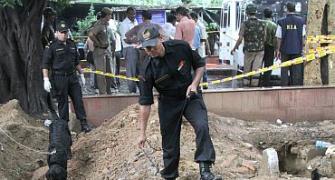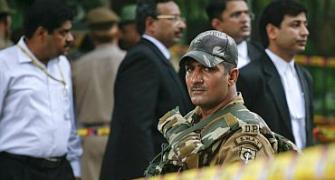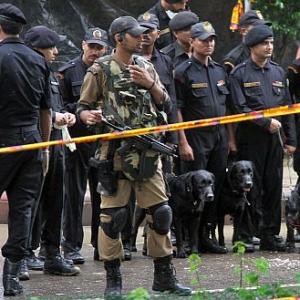The bomb that exploded outside the Delhi high Court on Wednesday was laced with the highly-impactive pentaerythritol tetranitrate, popularly known as PETN. The deadly chemical is a favourite terror toy of Pakistan based terror groups like the Lashkar-e-Tayiba and Al Qaeda, reports Vicky Nanjappa.
The presence of pentaerythritol tetranitrate, used for heart ailments to smoothen blood flow, in the bomb that exploded at the Delhi high court on Wednesday has given a new dimension to the case. PETN has rarely been used by a terrorist group in India. Till now, a study of most blasts in the country indicates the use of RDX and ammonium nitrate for bomb making.
In fact, terrorists had also stopped the use of RDX and relied heavily on the use of ammonium nitrate, as it is easily available. The forensic team studying the composition of bomb that was used to trigger Wednesday's blast has found traces of PETN. This points out that a well-established terror organisation was behind the attack.
PETN is not easily available and is a deadly explosive. It has been often used by the Lashkar-e-Tayiba and Al Qaeda in the past. The use of the deadly chemical in the Delhi bombing has made it clear that it has been smuggled from aboard and has been stocked in terror camps across the border.
According to forensic experts, PETN is a very powerful explosive and can create an impact similar to RDX. It is normally mixed with a plasticiser and attached to an improvised explosive device.
Not only can PETN have a devastating impact when triggered, but is also difficult to trace. Because of its plastic nature, the explosive can easily pass metal detectors. Even sniffer dogs cannot detect it because of its low-pressure molecules. (very little gets into the atmosphere, so it is difficult to detect). Moreover, PETN has extremely low vapour pressures, which gives plastic explosive its form and consistency.
PETN, though manufactured in India is not easy to source because of various regulations regarding its use.
The same is the case with RDX. Past investigation shows that the RDX used in blasts has been provided to terror groups by the Pakistan establishment and is later smuggled to India. And the hand of Pakistan in providing material for the Delhi HC blast cannot be ruled out, say sources.
Security officials point out that PETN has been extensively used in Jammu and Kashmir, as terrorists can easily smuggle the material to the valley from Pakistan, say insiders.
Those probing the Delhi HC blasts case will be looking at the Kashmir connection as well. But the quantity of PETN used in the bomb at the Delhi HC was not abundant and hence procuring it would have been no big task.
Intelligence Bureau officials say that the trend is a new one and gives the indication that terror groups are likely to use highly impactive explosives in future attacks.
It may be recalled PETN was extensively used in the bombing of the Rashtriya Swayamsevak Sangh in Chennai in 1993. While the trial court had accepted the version of the police that PETN and RDX were used in the blasts, the Supreme Court of India rejected this theory since the investigating officers were unable to prove the origin of the PETN.









